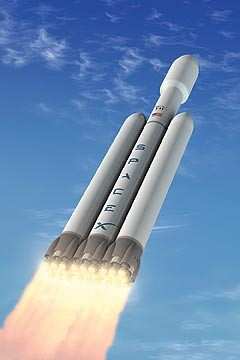Falcon Heavy Will Lift More Than Twice As Much As Any Other
Launch Vehicle
Elon Musk, CEO and chief rocket designer of Space Exploration
Technologies (SpaceX) has unveiled the final specifications and
launch date for the Falcon Heavy, what will be the world's
largest rocket.

Artist's Rendering
"Falcon Heavy will carry more payload to orbit or escape
velocity than any vehicle in history, apart from the Saturn V moon
rocket, which was decommissioned after the Apollo program. This
opens a new world of capability for both government and commercial
space missions," Musk told a press conference at the National Press
Club Tuesday in Washington, DC. "Falcon Heavy will arrive at our
Vandenberg, California, launch complex by the end of next year,
with liftoff to follow soon thereafter. First launch from our Cape
Canaveral launch complex is planned for late 2013 or 2014."
Musk added that with the ability to carry satellites or
interplanetary spacecraft weighing over 53 metric tons or 117,000
pounds to orbit, Falcon Heavy will have more than twice the
performance of the Space Shuttle or Delta IV Heavy, the next most
powerful vehicle, which is operated by United Launch
Alliance, a Boeing-Lockheed Martin joint venture.
Just for perspective, 53 metric tons is more than the maximum
take-off weight of a fully-loaded Boeing 737-200 with 136
passengers.
Falcon Heavy's first stage will be made up of three nine-engine
cores, which are used as the first stage of the SpaceX Falcon 9
launch vehicle. It will be powered by SpaceX's upgraded Merlin
engines currently being tested at the company's rocket development
facility in McGregor, TX. Falcon Heavy will generate 3.8 million
pounds of thrust at liftoff. This is the equivalent to the thrust
of fifteen Boeing 747s taking off at the same time. Above all,
Falcon Heavy has been designed for extreme reliability. Unique
safety features of the Falcon 9 are preserved, such as the ability
to complete its mission even if multiple engines fail. Like a
commercial airliner, each engine is surrounded by a protective
shell that contains a worst case situation like fire or a chamber
rupture, preventing it from affecting other engines or the vehicle
itself.
Anticipating potential astronaut transport needs, Falcon Heavy
is also designed to meet NASA human rating standards, unlike other
satellite launch vehicles. For example, this means designing to
higher structural safety margins of 40% above flight loads, rather
than the 25% level of other rockets, and triple redundant
avionics.

Falcon Heavy will be the first rocket in history to do
propellant cross-feed from the side boosters to the center core,
thus leaving the center core with most of its propellant after the
side boosters separate. The net effect is that Falcon Heavy
achieves performance comparable to a three stage rocket, even
though only the upper stage is airlit, further improving both
payload performance and reliability. Crossfeed is not required for
missions below 100,000 lbs, and can be turned off if desired.
Despite being designed to higher structural margins than other
rockets, the side booster stages will have a mass ratio (full of
propellant vs empty) above 30, better than any vehicle of any kind
in history.
Falcon Heavy, with more than twice the payload, but less than
one third the cost of a Delta IV Heavy, will provide much needed
relief to government and commercial budgets. In fact, Falcon Heavy
at approximately $1,000 per pound to orbit, sets a new world record
in affordable spaceflight.
This year, even as the Department of Defense budget was cut, the
EELV launch program, which includes the Delta IV, still saw a
thirty percent increase. The 2012 budget for four Air Force
launches is $1.74B, which is an average of $435M per launch. Falcon
9 is offered on the commercial market for $50-60M and Falcon Heavy
is offered for $80-$125M. This price includes all non-recurring
development costs and on-orbit delivery of an agreed upon mission.
For government missions, NASA has added mission assurance and
additional services to the Falcon 9 for less than $20M.
|
Vehicle Overview
|
|
| Mass to Orbit (200 km, 28.5 deg) |
53 metric tons (117,000 lbs) |
| Length |
69.2 meters (227 ft) |
| Max Stage Width |
5.2 m (17 ft) |
| Total Width |
11.6 meters (38 ft) |
| Weight at Liftoff |
1,400 metric tons or 3.1 million lbs |
| Thrust on Liftoff |
1,700 metric tons or 3.8 million lbs |
SpaceX says Falcon Heavy should not be confused with the super
heavy lift rocket program being debated by the US Congress. That
vehicle is intended to carry approximately 150 tons to orbit. The
company agrees with the need to develop a vehicle of that class as
the best way to conduct a large number of human missions to
Mars.
 ANN's Daily Aero-Linx (04.16.24)
ANN's Daily Aero-Linx (04.16.24) Aero-News: Quote of the Day (04.16.24)
Aero-News: Quote of the Day (04.16.24) Airborne 04.10.24: SnF24!, A50 Heritage Reveal, HeliCycle!, Montaer MC-01
Airborne 04.10.24: SnF24!, A50 Heritage Reveal, HeliCycle!, Montaer MC-01 Airborne 04.12.24: SnF24!, G100UL Is Here, Holy Micro, Plane Tags
Airborne 04.12.24: SnF24!, G100UL Is Here, Holy Micro, Plane Tags Airborne-Flight Training 04.17.24: Feds Need Controllers, Spirit Delay, Redbird
Airborne-Flight Training 04.17.24: Feds Need Controllers, Spirit Delay, Redbird




